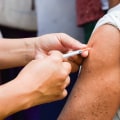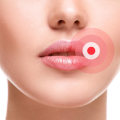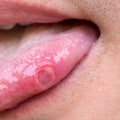The visual inspection of sores or blisters is a crucial step in diagnosing oral herpes. While it can be challenging to identify the presence of herpes with the naked eye, it is still an important tool for diagnosing this highly contagious virus. In this article, we will provide an overview of the visual inspection process, including how to identify common signs and symptoms of oral herpes. It is important to note that visual inspection alone is not enough to diagnose herpes. It should be used in combination with other diagnostic tests, such as a blood test or swab test, to confirm the presence of the virus.
Nevertheless, a visual inspection can provide valuable insight into whether or not oral herpes may be present. When inspecting sores or blisters, it's important to note the size, shape, color, and texture. Additionally, look for any signs of infection such as redness, swelling, pus, or warmth. If the sore or blister is filled with fluid, it's important to note whether it is clear or cloudy. It's also important to note if there are any other symptoms present such as fever, fatigue, or pain.
The location of the sore or blister can also be an important indicator. For example, sores or blisters on the face may indicate herpes simplex virus (HSV) while sores on the feet may indicate athlete's foot. Once all the necessary information has been gathered from the visual inspection, a diagnosis can be made. The most common causes of sores or blisters include infections such as HSV, shingles, and chickenpox; allergies; skin disorders such as eczema and psoriasis; irritants such as chemicals or plants; and physical trauma. Depending on the cause, treatment can range from antibiotics to topical creams to lifestyle changes.
It is important to make sure that the diagnosis is accurate before starting any kind of treatment. At times, sores and blisters can be caused by something other than an infection, allergy, skin disorder, irritant, or physical trauma. In these cases, a doctor may order additional tests to get a more accurate diagnosis. These tests can include blood tests, skin biopsies, or imaging tests. Visual inspection is an important part of diagnosing sores or blisters. It can help determine the cause and type of sore or blister, which in turn can help a person receive the right treatment.
By taking note of the size, shape, color, texture, fluid content, symptoms present, and location of sores and blisters, a doctor can make an accurate diagnosis and begin the appropriate treatment.
Common Causes of Sores and Blisters
Visual inspection is an important part of diagnosing sores or blisters. There are several common causes of sores and blisters that can be identified through visual inspection. The most common causes of sores or blisters include infections such as HSV, shingles, and chickenpox; allergies; skin disorders such as eczema and psoriasis; irritants such as chemicals or plants; and physical trauma. Infections such as HSV, shingles, and chickenpox can cause sores or blisters on the skin. HSV, or herpes simplex virus, is a sexually transmitted infection that can cause painful sores and blisters on the genitals, anus, and mouth.Shingles is caused by the varicella-zoster virus, which is also responsible for causing chickenpox. This virus can cause a painful rash with blisters on any part of the body. Allergies can also cause sores or blisters. Allergic reactions to certain foods, medications, or environmental allergens can cause skin to become inflamed and develop lesions. These lesions may be filled with fluid and look like sores or blisters. Skin disorders such as eczema and psoriasis can cause rashes with sores or blisters.
Eczema is an inflammatory skin condition that can cause itchy, red rashes with bumps that may ooze clear fluid. Psoriasis is a chronic skin condition that causes thick red plaques with silvery scales that may be filled with pus. Irritants such as chemicals or plants can also cause sores or blisters. Contact dermatitis is a skin condition caused by contact with certain chemicals, plants, or fabrics that can cause itching, redness, and blistering. Finally, physical trauma can cause sores or blisters to form. Blisters are often caused by friction from tight shoes or clothing that rubs against the skin.
Other types of physical trauma may also cause sores or blisters to form. Visual inspection is an important part of diagnosing sores or blisters. By looking for the common causes discussed above, a person can get an idea of what might be causing their sores or blisters. This information can help them receive the right treatment for their condition. Visual inspection is an important part of diagnosing sores or blisters. By noting the size, shape, color, texture, and location of the sore or blister, along with any accompanying symptoms, it is possible to make a diagnosis.
Common causes of sores and blisters include infections, allergies, autoimmune disorders, and skin conditions such as eczema. Depending on the cause, treatment can range from antibiotics to topical creams to lifestyle changes.


